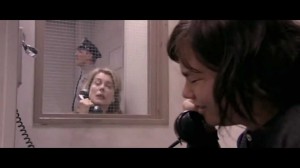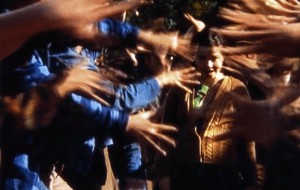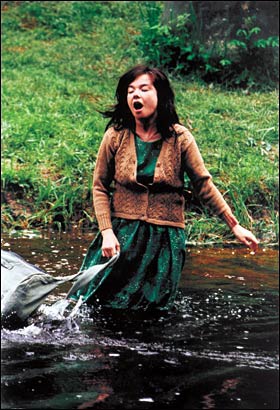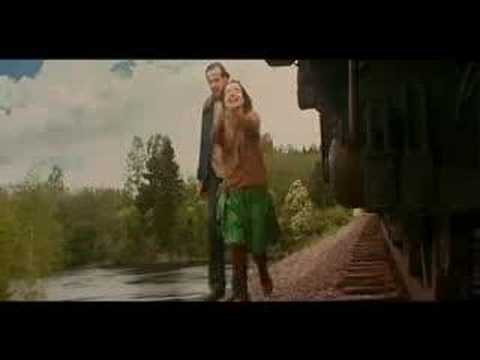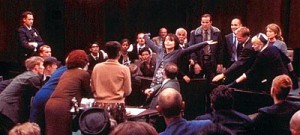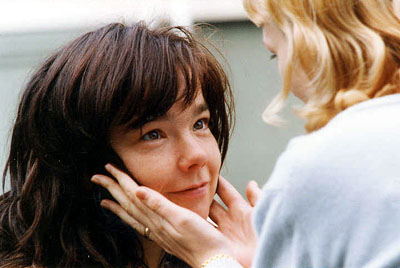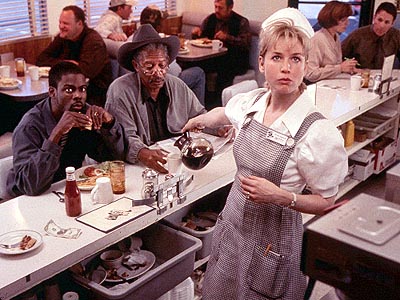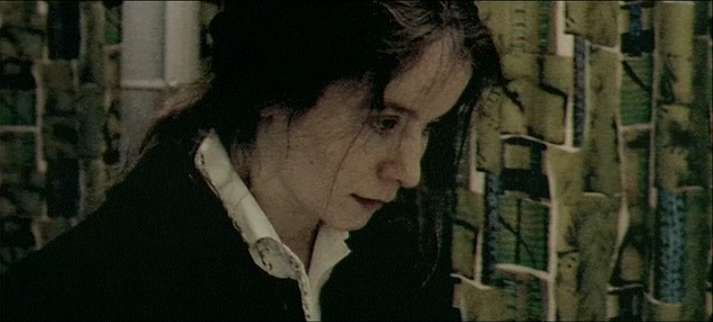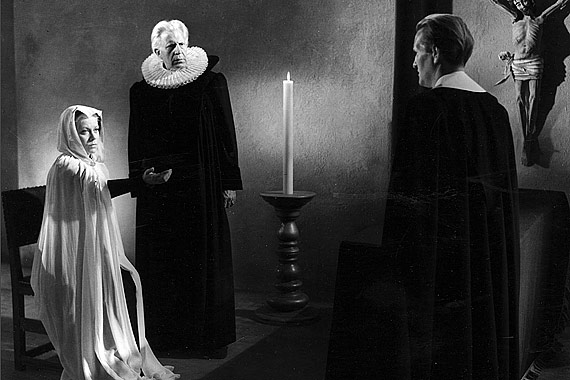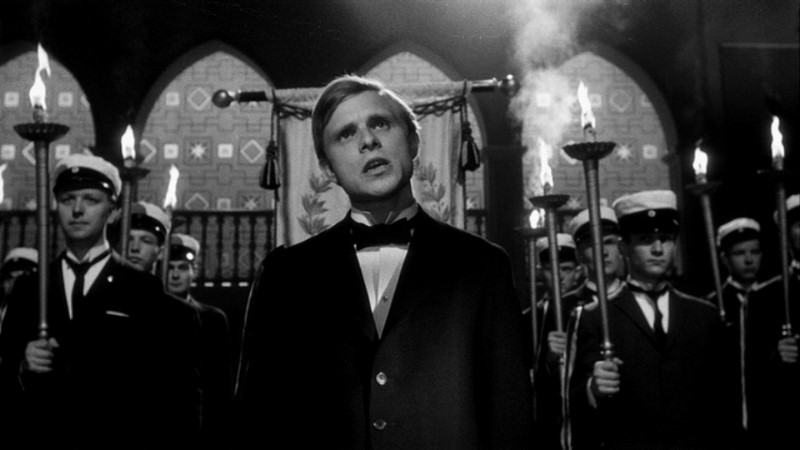From the Chicago Reader (October 27, 2000). — J.R.
Dancer in the Dark
**
Directed and written by Lars von Trier With Bjork, Catherine Deneuve, David Morse, Peter Stormare, Joel Grey, and Jean-Marc Barr.
To put it in the singsongy fashion of its own tacky musical numbers, Lars von Trier’s Dancer in the Dark enrages as well as engages, but I must confess that it also fascinates with its capacity to elicit extreme reactions. Ever since this musical about a woman from communist Czechoslovakia working in an American factory won the Palme d’Or and best actress prize (for rock star Bjork) from a Cannes jury headed by Luc Besson — one of the only Europudding directors who’s both crass and clever enough to rival von Trier as the most shameless sensationalist around — it has provoked hysterical reactions, pro as well as con. Viewers are struck by its technology (it was allegedly shot with 100 stationary digital cameras) as well as its aesthetics, its setting and social aspects, and its melodramatic story, not to mention its musical numbers. Though the movie certainly has its American defenders, many of its most vociferous detractors come from this country too. It’s not too surprising considering that this movie offers a horrific view of the American justice system, one you’d expect to find in an east European propaganda film shot 40 or 50 years ago. The musical numbers reek of some of the same flavor and intolerant anticommunist Americans are much in evidence. Von Trier — a Dane who has never set foot in this country and has no intention of doing so because of his aversion to planes — had communist parents who considered musicals capitalist rubbish, and Singin’ in the Rain provided one of his formative childhood experiences. Something personal as well as highly exploitative is being worked out here, and watching it spread like a virus across the screen and 139 minutes is part of its fascination.

In a way, von Trier’s postmodern blend of national flavors is one way of acknowledging that nationalities are beginning to die out — that multinational companies, not national governments, are making most of the decisions that count nowadays, including those that map out our futures. For a Danish filmmaker to make it in movies, switching to the English language and opting for an American setting, even an ersatz one, are a necessary part of the game; so are gimmicks like the Dogma 95 Manifesto, the call for a technically austere cinema, which worked on the credulous American press exactly the way it was designed to when von Trier and Thomas Vinterberg turned up in Cannes five years ago with The Idiots and The Celebration, respectively. (Not surprisingly, both filmmakers discarded the same gimmick as soon as it registered, and others have been picking it up ever since, sometimes with similar motivations.)
It’s ironic that nationality is disappearing now that this country is more culturally isolationist than it’s ever been. But the difference between, say, a Steven Spielberg and a Lars von Trier has become increasingly esoteric; indeed, when one hears that Spielberg has been showing interest in making a Dogma film, it’s clear that one major multinational hustler has been successfully conned by another one who’s still on the rise.
About those 100 stationary digital cameras: admittedly von Trier showed some talent for technical innovation in Zentropa, but given his equally demonstrated talent for publicity stunts, I hope I can be forgiven for a certain skepticism. The highly gifted Dutch cinematographer Robby Muller is credited as director of photography and von Trier is listed as the only camera operator. What role did Müller play exactly? And can we trust the implied claim that 100 cameras were used in every shot, or were they employed only at certain junctures, such as in the musical numbers? Even if all hundred were used only during the numbers, it still sounds like a spectacular waste of resources, because it doesn’t look like the fruits of more than a dozen turned up in the final edit. And when it comes to certain nonmusical scenes in cramped spaces, such as those in the heroine’s trailer, it’s particularly hard to figure out how so many cameras could have been used without any of them becoming visible. Frankly, the whole bit sounds like the latest version of Dogma 95 — a way to get acres of press coverage from yokels who can’t be bothered with more subtle notions of film aesthetics. (Did Sony foot the bill in exchange for free advertising?)
The implication of the multiple cameras is that they gave von Trier more choices when it came to editing. But since von Trier, more economist than aesthete, edits the results like the sloppiest of music videos — with rapid and frequent jump cuts between diverse angles often calling more attention to the show-offy technique than to the story or Bjork’s performance — the extra choices lead to a greater sense of chaos. And because the choices are basically between various shots that all have lousy resolution and definition, the losses in abandoning 35-millimeter cameras seem greater than the gains.
Bjork — a pop sprite with a Raggedy Ann appearance, an ethereal voice, and, judging from her score in this movie, not much aptitude for a catchy tune — is Icelandic, but von Trier has made her a Czech immigrant without worrying too much about her accent. With a comparable sense of practicality, he cast Catherine Deneuve, a French superstar who usually signifies glitz, in a part originally scripted for the character of a poor black woman — the Czech woman’s best friend and coworker. In Film Comment, Gavin Smith noted that “of the 13 leading actors, only five are American, and the rest are Icelandic, French, Swedish, English, French-Canadian and German. This is less a question of melting-pot realism than pastiche, and the main ingredient in this pastiche is the musical genre itself.” Another ingredient, one informing the casting as well as the plot, is boilerplate anti-Americanism.
The story involves Selma (Bjork), a single mother living with her ten-year-old son Gene (Vladica Kostic) in a trailer in rural Washington State in 1964. She works at a tool-and-die factory making stainless steel sinks and supplements her income by carding hairpins at home. Though she keeps it a secret, she is going blind from a hereditary disease that will also eventually strike Gene unless she can squirrel away enough money to pay for an operation. Her only pleasures are rehearsing the part of Maria for a community-theater production of The Sound of Music, accompanied by her friend Kathy (Deneuve), and sometimes going with her to see classic 30s Hollywood musicals at a local theater, rural Washington State in 1964 apparently being a hotbed for cinephiles. (She and Kathy like to chatter during the two movies we see them attending, and the same irate man is seated in front of them both times, in the same row.) Meanwhile, her neighbor and landlord Bill (David Morse), a cop, confides to her that he’s about to lose everything, including his house, because his savings have run out, something his spendthrift wife Linda (Cara Seymour) knows nothing about. Selma confides her secret about her disease to him, and before long Bill spies on her to see where she hides her nest egg. Meanwhile, she loses both her factory job and her role as Maria in The Sound of Music because of her encroaching blindness — a problem she continues to deny to everyone so as to keep the truth from her son.
After Selma refuses Bill when he asks for a loan, he steals her money. Going to retrieve it, Selma encounters Linda, who says Bill told her Selma came on to him sexually. When Selma confronts Bill, he pulls a gun and demands that she put him out of his misery if she wants her money back. After a struggle he’s wounded, and when he begs her to finish him off, she complies, in drawn-out, gory detail, inflicting 34 wounds in all — first with the gun and then with the money box when she runs out of bullets. (Why von Trier didn’t make it a full hundred wounds to match the number of video cameras isn’t entirely clear to me.) After depositing her savings with the eye doctor (played by Udo Kier, one of Rainer Werner Fassbinder’s favorite standbys for sadists), she’s arrested for murder, and, after a trial in which she continues to hide the truth about Gene’s eyesight, claiming that she killed Bill only after trying to rob him, she’s sentenced to death by hanging. She won’t agree to an appeal because the new lawyer would have to be paid with the money for Gene’s operation, and, with the help of a sympathetic prison guard, she walks fearfully to her death.
Interspersed with these events are original songs written and performed by Bjork and choreographed by Vincent Paterson — in the factory, rehearsal hall, courtroom, and state pen, on a railway bridge, and in Bill’s house and environs immediately after the murder (Bill comes back to life long enough to join in the first part of the song and dance). These numbers are obviously meant to represent Selma’s fantasies, but a couple dovetail with the action so we can’t tell exactly when and where one ends and the other begins. All of them look ugly, at least to my eyes — but then again so do most of the film’s splotchy digital images — and they don’t sound like much either. But they’re full of raw emotion, and von Trier is banking on the premise that emotion is all that ultimately matters.
I’m reminded of Wallace Shawn’s machocentric speculation in My Dinner With Andre that people in the future may get themselves castrated just to prove that they can still feel something: watching women suffer on-screen may prove equally effective and less messy, at least for male viewers, and the pile-driver effect of Selma inflicting those 34 wounds shouldn’t be sneezed at either. So if you’re feeling numb, I can heartily recommend Dancer in the Dark as a movie happy to do anything and everything to alleviate that condition — including hit you on the head with a blunt instrument, as Selma does to Bill. (Was I moved? You bet I was.)
On the other hand, the song and dance number immediately following the murder is the most inventive in the film, visually as well as conceptually, incorporating God’s-eye views from the sky as well as drastically tilted angles inside Bill’s house, and factoring in a nearby river as well as a neighboring house’s backyard to memorable effect. So if the plot contrivances leading up to and through the murder strike you as offensive and not simply as a believable depiction of how the economic desperation of two individuals can lead to such violence, stick around for this highly ambiguous and disturbing fantasy interlude. It’s the only part of the film where von Trier takes risks with his storytelling. Even here, the digital textures are unattractive, but at least the physical terrain is striking. It’s my second favorite stretch of the movie, after the brief patch of black leader that comes just before the credits — the only time in the film when we’re allowed to share Selma’s darkness.
Far uglier than the video textures are the slow overlapping dissolves of abstract paintings that in American prints replace a much longer stretch of darkness during the film’s musical overture, apparently because someone decided that Americans, unlike everyone else, won’t sit still for music without a screen image. I don’t know whether von Trier had anything to do with this decision, but given the periodic visual flair he shows elsewhere, it’s hard to believe he came up with these hideous images. Whoever did could take a lesson from American independent Jon Jost, whose recent Muri Romani creates gorgeous and spellbinding effects from overlapping silent digital video images of diverse Roman walls at a much slower speed.
And whoever decided to distinguish American viewers from all others, it’s worth noting that the experience of being not American is crucial to the film’s meaning, and may even be the most interesting thing about it. Why did Selma come to America? To make enough money for her son’s operation. And why did von Trier set his film in America? Take a guess.
To be fair, I’ve recently read two interesting defenses of the film. The longer one — an article by Johnny Ray Huston in the San Francisco Bay Guardian that explores in detail the relation of the film to both music videos and the late Hollywood melodramas of Douglas Sirk — only confirms my overall distaste for most music videos and most of the late Hollywood Sirk melodramas (aside from their lighting and beautiful uses of Technicolor — which frankly make any wide-screen frame of Dancer in the Dark look like something the cat dragged in and then sprayed on). I know these latter movies have been deemed politically as well as academically correct for a good quarter of a century, but they’re too cynical, manipulative, and mercantile for me, at least in their depictions of suffering, and the likelihood that they’ve inspired von Trier only makes them more repugnant to me. (The fact that he’s added the “von” to his own name tells you something about where he’s coming from.)
The shorter defense provides me with much more food for thought. It’s a review of both Dancer in the Dark and Nurse Betty by an Argentinean critic named Quintin in the summer issue of the Canadian magazine Cinema Scope, explaining why, in contrast to most Americans, he liked the former and hated the latter when they both surfaced at Cannes. I don’t agree with it, though maybe that’s just because I’m not one of the non-Americans Quintin is speaking for and about. But I find it provocative as a reading of what non-Americans might hope to find in global art cinema.
Noting that both films play “with the impact of entertainment on ordinary characters,” Quintin argues that Nurse Betty, which comes “with the instructions included,” is a quintessentially American “confession [that] cinema is helpless to deal with anything except its own games.” (Parallel examples that might reinforce his argument are Wag the Dog and The Truman Show.) But audiences across the world who aren’t American (in fact the majority) have “learned to love American images and sounds” (such as musicals) but have also “learned how to make them their own, to interpret them as they pleased,” and Dancer in the Dark speaks to that process honestly as well as universally. The musical numbers, however clumsy, are “charged with unique accents of pain. That’s one of the clues to what the film is trying to say: that pain and injustice are still there. And that cinema is capable of respecting pain, and seeking its truth. There is no pain in Nurse Betty. Just death.”
In other words, von Trier’s film, however personal, offers a kind of lingua franca for other excluded non-Americans who want to claim a piece of the pie in terms of their own experience. By this criterion, the faulty details in the rural Washington von Trier constructed in Sweden are surely no worse than the mountains you can see on the horizon in Gilda‘s Buenos Aires. What counts, really, is the modesty of Selma’s wishes: “All she wants to do is dance, to ease her suffering.”
Maybe it’s a function of being American, but what Quintin finds touching I find infuriating. In fact, Selma asks for so little, complains so seldom, and is in such perpetual denial about her problems that I find her virtually indigestible as a character. The movie’s not so much about her modesty and compliance –the stupid grin with which she greets virtually every misfortune — as it is about von Trier’s appreciation of her passive suffering (not quite the same thing as respect or understanding), which ultimately becomes an exaltation of his own feeling rather than hers.
Perhaps this is what British critic Paul Willemen had in mind when he recently suggested, in the on-line film journal Framework, that “it would be easy to do a reading demonstrating that many of the [Dogma] films constitute barely cloaked attempts to come to terms with a desire to abuse children (or barely adult people, mostly female, with learning difficulties).” Technically, of course, neither Breaking the Waves nor Dancer in the Dark qualify as Dogma films — unlike The Idiots, the middle feature in von Trier’s “Golden Heart” trilogy. But considering the fervor with which in both films he imposes highly contrived worst-case scenarios on obsessively focused, uncomplaining, and childlike heroines who behave like mental defectives, it’s a hypothesis that can’t be entirely shrugged off. The queasy mixture of worship and condescension, admiration and sadomasochistic relish evokes Fassbinder and his professed mentor, Sirk — though at least Sirk and Fassbinder had leftist political agendas to complicate their scenarios (concealed in Sirk’s case, blatant in Fassbinder’s). Von Trier, by contrast, aspires only to affect us, not to change anything at all about the way we live — something that becomes especially apparent if one juxtaposes the social rebellion in The Idiots with any of the countercultural films of the late 60s and early 70s that it apparently emulates. “I’m deeply against the death penalty,” he notes in the press book for Dancer in the Dark. “On the other hand, execution scenes are God’s gift to directors. They’re very efficient. If you’re going to be a martyr you have to die.” And guess which sentiment wins out in the end.
So is it really admiration for Selma that the film expresses, or a certain malice crossed with sympathy for the suffering of a dumb animal? Maybe it’s some of both, meaning that what Quintin and I and Willemen see derives in part from what our respective experiences teach us to look for. Speaking in an interview about her much-publicized battles with von Trier before, during, and after shooting, Bjork noted that after seeing Breaking the Waves, she assumed he identified with its heroine but subsequently decided that he actually identified with her sicko husband. In Dancer in the Dark, I think he identifies not only with both Selma and Bill, which is natural, but also with both the money box and the rope that hangs Selma (which he shows us implicitly leading all the way up to heaven).
When I first saw Breaking the Waves, I was fascinated by its dialectic between narrative and nonnarrative, which clearly came from another of von Trier’s favorite filmmakers and role models, his fellow Dane Carl Dreyer. This year, Dreyer’s last three features, which I regard as his finest works and three of the greatest films ever made — Day of Wrath (1943), Ordet (1955), and Gertrud (1965) — have become available on video for the first time, in decent prints from Home Vision Cinema. This means that even though we usually can’t see those decent prints on film in the U.S., the greatness of these films can finally become something more than a faint rumor.
Unlike von Trier, Dreyer was such a bad hustler — and his films were so uncommercial — that after shooting nine silent films in ten years (1919-1928) he barely managed to make more than one film per decade during the entire sound era. A multinational in his own right, he made films in Sweden, Norway, Germany, and France as well as Denmark, and also had unrealized projects that he wanted to shoot in the U.S. as well as the Middle East. Today it seems likely that he wouldn’t have a prayer of getting any of his 14 features made. To say that he could shoot them on digital video would be like saying that Frank Lloyd Wright could design houses to be built exclusively out of marzipan: sure he could, but who would want to live in them? Lars von Trier makes movies out of marzipan, and if our multinational supervisors have their way, we may not have any other kind to see or live in — full of sound, fury, and emotion and instantly disposable. The man’s a fucking seer, and Dancer in the Dark shows us the way.

